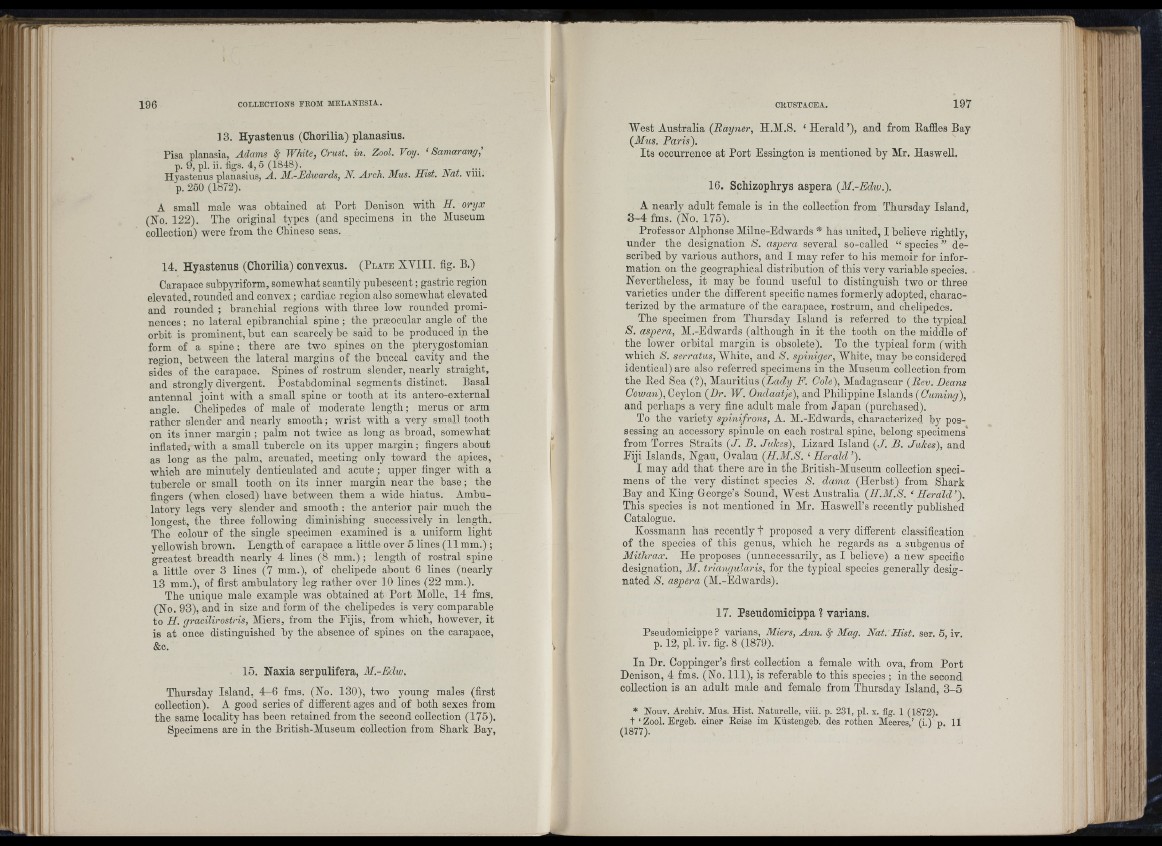
i l
COLLECTIONS FEOM MELANESIA.
] 3. Hyastenus (Chorilia) planasius.
Pisa planasia, Adams White, Crust, in. Zool. Voy. ‘ Samarang,
p. 9, pi. ii. figs. 4,5 (1848).
Hyastenus planasius^ A, M.-Edwards^ N. Arch. Mus. Hist, Nat. viii.
p. 250 (1872).
A small male was ohtained at Port Denison with H. oryx
(No. 122). The original types (and specimens in the Aluseum
collection) were from tho Chinese seas.
14. Hyastenus (Chorilia) convexus. (P late X V III. fig. B.)
Carapace subpyriform, somewhat scantily pubescent ; gastric region
elevated, rounded and convex ; cardiac region also somewhat elevated
and rounded ; branchial regions with three low rounded prominences
; no lateral epibranchial spine ; the præocular angle of the
orhit is prominent, hut can scarcely be said to he produced in the
form of a spine ; there are two spines on the pterygostomian
region, between the lateral margins of tho hnccal cavity and the
sides of the carapace. Spines of rostrum slender, nearly straight,
and strongly divergent. Postabdominal segments distinct. Basal
antennal joint with a smaü spine or tooth at its antero-oxternal
angle. Chelipedes of male of moderate length; merus or arm
rather slender and nearly smooth; wrist with a very small tooth
on its inner margin ; palm not twice as long as broad, somewhat
inflated, with a small tubercle on its upper margin ; fingers about
as long as the palm, arcuated, meeting only toward the apices,
which are minutely denticulated and acute ; upper finger with a
tubercle or small tooth on its inner margin near the base ; the
fingers (when closed) have between them a wide hiatus. Ambulatory
legs very slender and smooth : the anterior pair much the
longest, the three following diminishing successively in length.
Tho colour of the single specimen examined is a uniform light
yellowish brown. Length of carapace a little over 5 lines (11 mm.) ;
greatest breadth nearly 4 lines (8 mm.); length of rostral spine
a little over 3 lines (7 mm.), of chelipede about 6 lines (nearly
13 mm.), of first ambulatory leg rather over 10 lines (22 mm.).
The unique male example was ohtained a t Port Alolle, 14 fms.
(No. 93), and in size and form of the chelipedes is very comparable
to H. gracilirostris, Aliers, from the Pijis, from which, however, it
is at once distinguished by the absence of spines on the carapace,
&c.
15. Naxia serpulifera, M.-Edw.
Thursday Island, 4 -6 fms. (No. 130), two young males (first
collection). A good series of different ages and of both sexes from
the same locality has been retained from the second collection (175).
Specimens are in the British-Aluseum collection from Shark Bay,
CEUSTACEA. 197
AVest Australia (Bayner, H.Al.S. ‘ H e ra ld ’), and from Raffles Bay
(Mus. Paris).
Its occurrence at Port Essington is mentioned by Mr. HasweU.
16. Schizophrys aspera (M.-Ediu.).
A nearly adult female is in the collection from Thursday Island,
3 -4 fms. (No. 175).
Professor Alphonse Milne-Edwards * has united, I believe rightly,
under the designation S. aspera several so-called “ species ” described
by various authors, and I may refer to his memoir for information
on the geographical distribution of this very variable species.
Nevertheless, it may he found useful to distinguish two or three
varieties under the different specific names formerly adopted, characterized
by the armature of the carapace, rostrum, and chelipedes.
The specimen from Thursday Island is referred to the typical
S . aspera, Al.-Edwards (although in it the tooth on the middle of
the lower orbital margin is obsolete). To the typical form (with
which S. serratus, AVhite, and S. spiniger, AVhite, may be considered
identical) are also referred specimens in the Aluseum collection from
the Red Sea (?), Alauritius (Lady F. Cole), Aladagascar (Bev. Deans
Cowan), Ceylon (Dr. W. Ondaatje), and Philippine Islands ( Gtimwy),
and perhaps a very fine adult male from Japan (purchased).
To the variety spinifrons, A. Al.-Edwards, characterized by possessing
an accessory spinule on each rostral spine, belong specimens’
from Torres Straits (J. B. Juices), Lizard Island (J. B. Jakes), and
Eiji Islands, Ngau, Ovalau (H.Al.S. ‘ Herald’).
I may add that there are in the British-AInseum collection specimens
of the very distinct species S. dama (Herhst) from Shark
Bay and King George’s Sound, AVest Australia (H.M.S. ‘ Herald’).
This species is not mentioned in Mr. Haswell’s recently published
Catalogue.
Kossmann has recently t proposed a very different classification
of the species of this genus, which he regards as a subgenus of
Mithrax. He proposes (unnecessarily, as I believe) a new specific
designation, Ai. triangularis, for the typical species generally designated
S . aspera (M.-Edwards).
17. Pseudomicippa ? varians.
Pseudomicippe ? varians, Miers, Ann. <§• Mag. Nat. Hist. ser. 5, iv.
p. 12, pi. iv. fig. 8 (1879).
In Dr. Coppinger’s first collection a female with ova, from Port
Denison, 4 fms. (No. I l l ) , is referable to this species ; in the second
collection is an adult male and female from Thursday Island, 3 -5
* Nouv. Archiv. Mus. Hist. Naturelle, viii. p. 231, pi. x. fig. 1 (1872),
t ‘Zool. Ergeb. einer Eeise im Kiistengeb. des rotben Meeres,’ (i.) p. 11
(1877).
r i ; i !4
■ I,
4 ■' '
- ! i
i l
'ii;[
’■•'i'i
;i If
r '
j h;
* i , ‘
' 1
P
iI